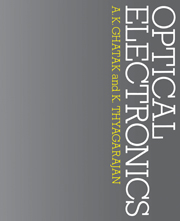Book contents
- Frontmatter
- Contents
- Preface
- 1 Maxwell's equations and propagation of electromagnetic waves
- 2 Reflection and refraction of electromagnetic waves
- 3 Wave propagation in anisotropic media
- 4 Fraunhofer diffraction
- 5 Fresnel diffraction
- 6 Spatial frequency filtering
- 7 Holography
- 8 Lasers: I
- 9 Lasers: II
- 10 Some laser systems
- 11 Electromagnetic analysis of the simplest optical waveguide
- 12 Leaky modes in optical waveguides
- 13 Optical fibre waveguides
- 14 Integrated optics
- 15 The electrooptic effect
- 16 The strain optic tensor
- 17 Acoustooptlc effect: Raman–Nath diffraction
- 18 Acoustooptic effect: Bragg diffraction
- 19 Acoustooptic devices
- 20 Nonlinear optics
- Appendices
- References and suggested reading
- Index
Preface
Published online by Cambridge University Press: 05 June 2012
- Frontmatter
- Contents
- Preface
- 1 Maxwell's equations and propagation of electromagnetic waves
- 2 Reflection and refraction of electromagnetic waves
- 3 Wave propagation in anisotropic media
- 4 Fraunhofer diffraction
- 5 Fresnel diffraction
- 6 Spatial frequency filtering
- 7 Holography
- 8 Lasers: I
- 9 Lasers: II
- 10 Some laser systems
- 11 Electromagnetic analysis of the simplest optical waveguide
- 12 Leaky modes in optical waveguides
- 13 Optical fibre waveguides
- 14 Integrated optics
- 15 The electrooptic effect
- 16 The strain optic tensor
- 17 Acoustooptlc effect: Raman–Nath diffraction
- 18 Acoustooptic effect: Bragg diffraction
- 19 Acoustooptic devices
- 20 Nonlinear optics
- Appendices
- References and suggested reading
- Index
Summary
Ever since the invention of the laser in 1960, there has been a renaissance in the field of optics and the field of optical electronics encompassing generation, modulation, transmission etc. of optical radiation has gained tremendous importance. With optics and optical electronics now finding applications in almost all branches of science and engineering, study of these subjects is becoming extremely important. The present book intended for senior undergraduate and first year graduate students is an attempt at a coherent presentation of the basic physical principles involved in the understanding of some of the important optoelectronic effects and devices.
The book starts with the basic formulation of the study of propagation of electromagnetic waves, reflection and refraction and propagation through anisotropic media. This is followed by diffraction and its application in the study of spatial frequency filtering and holography. Basic physics behind laser operation is treated next with a brief discussion on different laser types. The next four chapters deal with the subject of optical waveguides including fibre and integrated optics which are already revolutionizing the field of information transmission. The next five chapters deal with three very important effects which are used in many opto-electronic devices namely the electrooptic, acoustooptic and nonlinear optical effects.
The various concepts in the book have been derived from first principles and hence it can also be used for self study. A large number of solved and unsolved problems have been scattered throughout the book.
- Type
- Chapter
- Information
- Optical Electronics , pp. xi - xiiPublisher: Cambridge University PressPrint publication year: 1989



